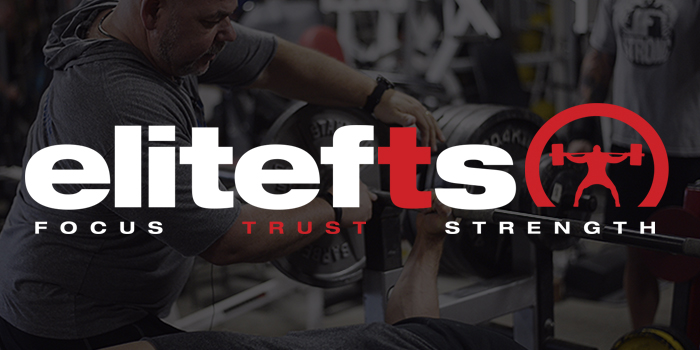
Originally published in August of 2017
There’s no phrase I hate worse than “how much ya bench, bro?” (Although “you need a root canal” is up there, too.) Bench has always been a weakness of mine: when I first started lifting, I struggled with 100 pounds. But to be honest, it never bothered me all that much until I started competing, and saw just how much my bench press was holding me back.
Even if you’re not a competitive powerlifter, you probably get frustrated with the bench at least some of the time. It’s the universal barometer of bro-strength — nobody ever asks how much you squat or pull, so if your bench is lagging, you can expect to lose a lot of gym cred. It’s often the slowest lift to progress, and, unlike squat or deadlift, you can’t really “muscle through” a tough rep. If you stall on the bench, more times than not, you’re missing the lift, or worse, maybe getting injured. And if your bench is nothing to write home about, there’s a good chance your chest, shoulders, and triceps leave a lot to be desired, too.
Given how important the bench is, and how much mine sucks, it should come as no surprise that when I had the chance to train with Dave at the elitefts Underground Strength Seminar this past June, I jumped at it. Dave is a true bench guru: I mean, he repped 385 in high school. And he’s written just a little bit about how to build a big bench, too — just check out the Benchipedia, Dave Tate’s free bench press manual.
Dave Fixing My Pitiful Bench Press:
1. Set the shoulder girdle and lats better.
My upper back is definitely a strength, and I’ve noticed that the tighter I can set my shoulders — especially my rear delts — the more confident I felt on the descent of the press, and the stronger I felt off my chest. But, as a result, that meant I was focusing entirely on setting those rear delts, wasn’t driving my shoulders down enough, and my setup was sub-optimal.
Dave suggested that I use the same technique to set my lats and upper back on the bench as I use on the squat. I get a lot of questions about why I begin my squat with a reverse grip before getting under the bar, so here’s the answer: the reverse grip lets me pull straight down on the bar with my lats before I get set. In the squat, activating my lats helps me to keep my torso upright and the bar seated more firmly on my back. In the bench, lats help to stabilize the bar during the descent and, if they’re thick enough, reduce range of motion a bit. Regardless of the lift, the reverse grip is a great proprioceptive tool to activate the lats, and my experience using it in the squat made for an easy transition to the bench.
2. Pull the bar out of the rack.
At nearly every meet I’ve ever done, I’ve gotten slow start commands on the bench press because my unrack is a little wacky — I protract my shoulders to get the bar out, and then reset them, and with all that shit going on up top, I don’t pay much mind to my elbows and squeezing my triceps so that it’s obvious they’re locked before I begin the lift. (They are locked; I couldn’t hang out at the top otherwise, but it’s hard to tell.)
Dave told me to unrack imagining that I was trying to strip the knurling off the bar using the J-hooks of the bench. Now, I love a good cue, and this is a great one. First, it’s very easy to visualize, and second, it forces me to keep my lats activated and use the correct movement without ever mentioning muscles or movement. “Stripping the knurling” forces me to unrack without losing any of that tension in my shoulders, and makes sure that my elbows stay in the same horizontal plane, so there’s no doubt that they’re locked out.
3. Don’t worry quite so much about bar path.
This one isn’t in the video, but afterward, I asked Dave if my bar path was okay, or if I needed to touch higher on my chest or press back more towards my face. I’d spent quite a bit of time over the past few months trying to press back more, and get in the good, J-shaped groove that puts both the chest and triceps in the best position throughout the lift. Dave thought my bar path looked okay, which was great to hear, because, as a result, I had a lot less to focus on during the lift itself.
Incorporating Cues into Training
Generally, when you’re trying to use a new cue in your training, it’s important to practice it often — but not necessarily every time you lift. Many coaches and lifters insist that to be successful, every rep needs to look the same, but that’s simply not realistic. First, if you’re lifting very close to your max, form is almost always going to break down in some way. Second, if you’re incorporating a new cue to one of your movements, there’s a good chance you’ll be weaker at first, just because you’re not used to the new pattern.
If you tried to do all your heavy sets using the new cue, you’d probably end up with little more than frustration and maybe even injury. Instead, I prefer to give myself many opportunities to practice a new cue on submaximal sets with speed or hypertrophy work. On my heavy training days, I don’t worry about it so much, knowing that, with time, the new pattern will begin to feel more natural and I’ll be able to transition more smoothly while still getting in all the heavy training that I need to see and feel progress.
Current Bench Training Setup:
Day 1: Strength
On this day, I follow the standard Think Strong programming for my competition bench. During my warmups, I pay careful attention to setting my shoulder and lats using a reverse grip and then stripping the bar as I pull it out of the rack. On my working sets, though, I just focus on moving the weight.
Sample strength day:
- 135x10
- 275x5
- 315x3
- 350x5
- 365x5
- 365x5
Day 2: Hypertrophy
This day is usually some form of incline press, at various angles but with a barbell, not dumbbells, and for high volume: 30-50 total reps over 3-8 sets. Despite the slight variation from the competition lift, I still focus on using the new cues for every set.
Sample hypertrophy day (incline bench):
- 135x10
- 225x5
- 255x10
- 255x10
- 255x10
Day 3: Speed
This is conventional speed work, using 55-65% of my 1RM with mini bands for 6-10 sets of 1-3 reps. The focus here is on keeping perfect form and moving the weight as fast as possible.
Sample speed day:
- 135x10
- 225x5
- 225 plus elitefts mini bands 8x3
The Results
Now, keep in mind that I’ve been struggling with accumulated injuries and illness for a good bit of the time since UGSS. But after only a month of consistent training using these cues, I’ve managed to hit the following marks:
- 435 for a touch and go single (previous best: 425)
- 402 for a paused double (previous best: 400 for a touch and go double)
- 375 for 3x5 (previous best: 375 for one set of 4)
- 330x11 (previous best: 315x10)
Based on those numbers, I’m revising my bench goal for Reebok Record Breakers in November, from 200 kilos up to 210 — a huge jump, especially considering it’s by far my worst lift.
If you’re changing up your technique, don’t necessarily expect overnight gains. Even small changes can take a while to practice and assimilate, and oftentimes, you won’t see any benefits at all until you’ve mastered a new technique. If that seems frustrating, try to reframe it as a challenge — and recognize that some of the fastest strength increases you’ll find in your training will come from finding the right technique cues for you.
BONUS: A Lat Exercise To Build Your Bench — Duffalo Bar Prone Row
Think you’ve figured out how to use your lats in the bench press, but haven’t seen any benefits? It’s possible that your lats aren’t strong enough to really help stabilize the bar on the descent or drive off your chest. Even if you’re strong at lat pulldowns or chins, that vertical pulling strength might not carry over into a horizontal plane. And exercises like T-bar and barbell rows can overwork a lower back that’s already fried from squats and deadlifts.
Prone rows are a great solution. Position yourself face-down on a bench that’s high enough so you can fully extend your arms while gripping a barbell overhand (it might be helpful to use 25-pound plates instead of 45s here). Row Duffalo bar towards your sternum by driving your elbows back. As you perform the movement, think about pulling the bar apart, just as you would with a bench press — this helps to keep your shoulders and upper back tight. Pause briefly at the top of the movement, really trying to squeeze your shoulder blades together.
This exercise is a real challenge, but give it a shot for 4-5 sets of 5-8 reps once a week, and see your bench strength shoot up!










